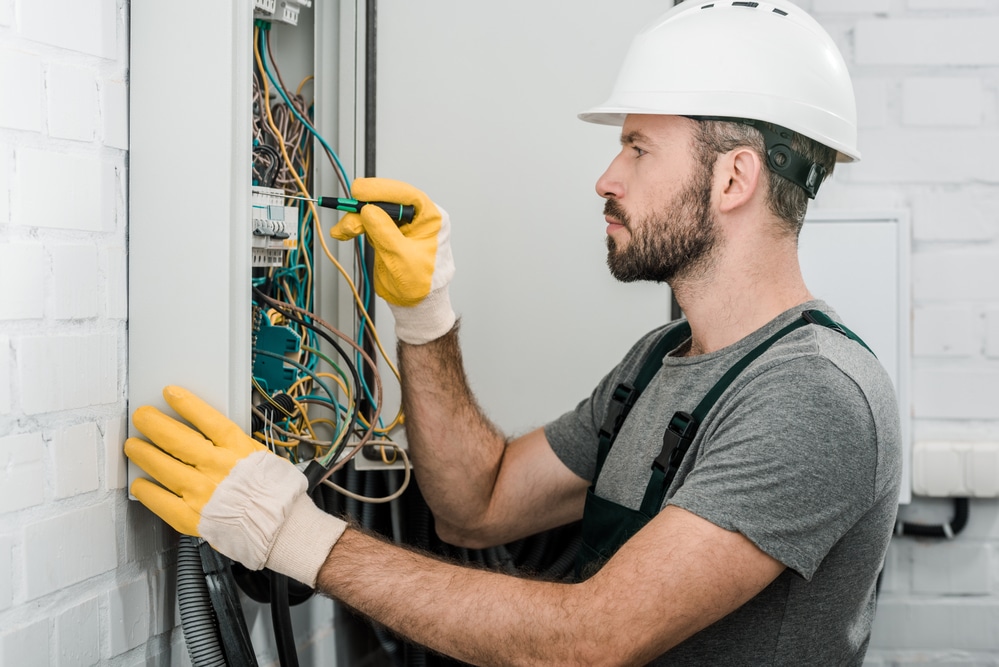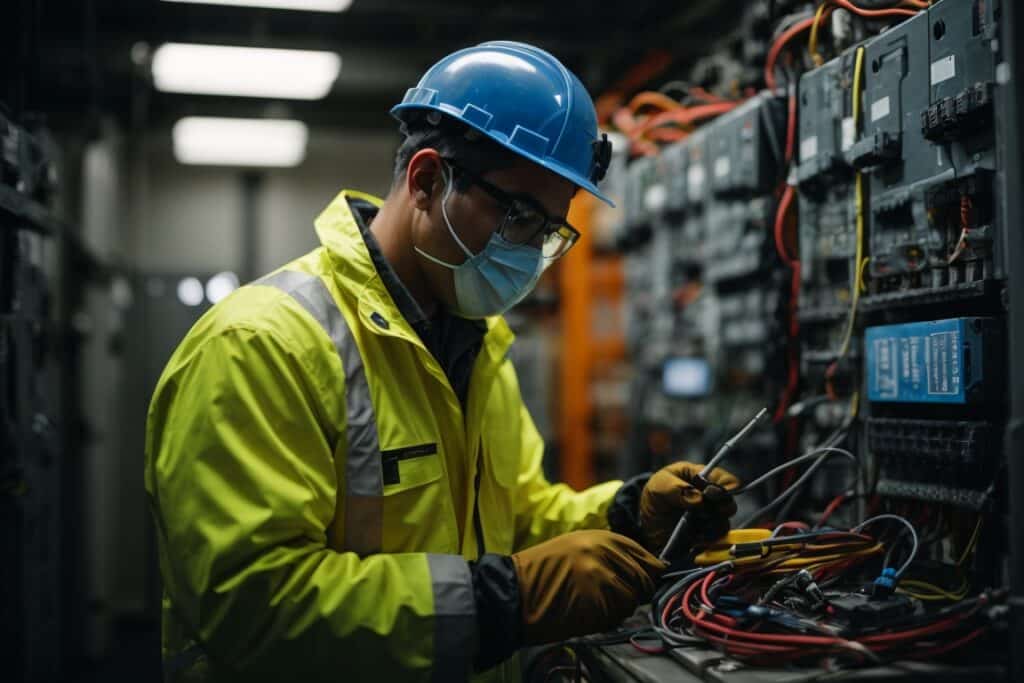Safety Challenges in Retrofitting Older Electrical Systems

Outdated electrical systems are often hazardous to replace. This is especially true when the surrounding infrastructure is outdated – it can make it difficult for electricians to access wiring, electrical panels, and other important electrical equipment.
OSHA provides safety regulations for working with outdated electrical infrastructure, but there’s no exhaustive list of the challenges faced by workers in historic buildings. The outdated systems may even have been installed around a building that predates electricity being commonly used in homes! Every case should involve a thorough safety inspection before work begins.
Here, I will outline the safety challenges in retrofitting older electrical systems and explain how you can protect employees while conducting this dangerous work. Also, since dealing with these older systems is a safety hazard, you should train your employees on arc flash safety.
Why Install Modern Electrical Systems in Older Buildings?
There are numerous reasons to upgrade outdated electrical systems. Most commonly, it’s a matter of safety and compliance with local electrical codes or federal regulations, but there are also other advantages to be gained by upgrading electrical panels and other electrical infrastructure.

Safety
An old electrical system may need to be updated because of safety concerns – electrical accidents are much more likely in older systems.
Modern systems use advanced safety features to reduce the risk of harm to individuals (such as electrical shocks) or damage to property through accidents like electrical fires. Smart control systems are typically installed during an upgrade or renovation to protect the building’s inhabitants. By the way, if you need information on how to provide first aid to an employee who has sustained an electrical or arc flash injury, we have a full write-up on that topic.
Convenience
Whether a building is used for residential or commercial purposes, the owners will enjoy better control over key functions when the system is upgraded. Modern appliances may be easier to power and at a lower cost, and building-wide systems such as heating and HVAC systems may run more effectively with a newer system.
Energy Efficiency
This is one of the main reasons to upgrade a system. Old systems may consume very high energy due to poor wiring systems or outdated components, leading to higher energy bills. Keeping an old building running while meeting modern demands is one of the primary challenges of maintaining historic buildings.
Owners can benefit from long-term cost savings when they improve energy efficiency with a newer system. They can also reduce the risk of power outages, which can be costly in commercial spaces as they impact the visitor experience.
Besides reducing electricity bills, a modern system can also help historic structures reduce their carbon footprint. Environmental responsibility is a goal in itself, but it could also potentially open the door to local incentives for reduced carbon usage.

Enhanced Use
Higher power quality means that modern electronic devices can more easily be powered across the building. This allows both residential and commercial buildings to offer a better experience to their inhabitants – for example, consistent Wi-Fi across the building.
Preserving Historic Buildings
A historic building may have existing infrastructure, which, when inspected by a licensed electrician, could fall short of local safety requirements. This could lead to the building being put off-limits for visitors or even require that it be torn down if proper adjustments can’t be made.
Preserving historic structures is an important cultural goal. By replacing outdated wiring, removing potential hazards, ensuring proper grounding, and generally updating the building’s infrastructure, managers of historic structures can ensure that these buildings remain accessible to the public and safe for new generations to appreciate and enjoy.

Common Challenges of Upgrading Electrical Systems in Old Buildings
Upgrading outdated electrical systems should only ever be done by a team of qualified professionals. There’s often a significant safety risk in replacing outdated safety features and dealing with faulty electrical wiring – proper safety measures should always be in place before work begins.
This all starts with an inspection. Here’s what electricians need to look out for.
1. Remaining Compliant with Building Codes
Workers should be aware of local building codes before work begins. This ensures that new electrical systems can be installed in a way that keeps historic structures viable while benefiting from enhanced safety.
Electrical installations should have the approval of local authorities from the word go. For example, if power needs to be provided through a new channel, it may mean that nearby ground needs to be dug up for new wires to be laid. This may require local approval – consultations between the local authority, the building’s owner or manager, and the electrician should be comprehensive.
2. Disrupting Residents or Commercial Occupiers
While a new electrical system has many benefits for users, its installation will likely inconvenience residents or commercial occupiers while in progress. There may be frequent power outages while infrastructure is being upgraded, as work should be conducted while systems aren’t live.
The electricians should make it clear if the property will be unusable for a certain amount of time. It may be necessary to vacate the property to allow work to be conducted safely and quickly.

3. Structural Issues
Historic buildings may have structural issues around areas where electrical components are installed. These should be identified by a qualified professional to ensure that electricians can put adequate safety measures in case.
An example is if electricians need to replace outdated wiring behind a wall. Suppose the wall turns out to have significant damp problems that compromise its structural integrity. The entire wall may need to be replaced, or electricians will encounter significant risks when working near it.
Unfortunately, costly repairs are a common feature of retrofitting an older building. However, these are infinitely preferable to losing the structure entirely.
4. Preserving Important Features
Historic buildings may have culturally significant features that need to be kept 100% intact during repairs. This is especially common for religious buildings with outdated electrical systems.
Workers should be made aware of these features before work begins. This ensures that they will be adequately protected while upgrades are ongoing.
Safely Retrofitting Historic Buildings: Key Challenges & Solutions
Electrical hazards are common when retrofitting older buildings, but there are other challenges facing electricians. Below is a list of key challenges and suggestions for how to address them.

Challenge #1: Unstable Structures
Work in older buildings often involves getting behind walls and under floorboards. Old structures may be unstable, and changes that would cause minimal disruption in modern buildings may expose wider problems.
Solution
The property should be thoroughly inspected before work begins to determine any associated dangers.
An external surveying company may need to be enlisted to identify how a property can be brought up to modern safety standards without endangering electricians during the process.
Challenge #2: Broken Electrical Panels, Wires, & Equipment
Electricians must prioritize safety when working with outdated electrical panels, wires, and other equipment. Electrical wiring may be loose or exposed and present in areas where wires wouldn’t be installed in more modern systems, increasing the risk of electrical shock. Always having the proper arc flash protection in the form of PPE is critical to any safety plan.
Solution
Workers should be provided with proper PPE for working in high-risk areas. As components such as loose copper or aluminum wiring may be present in unexpected areas due to stopgap maintenance jobs or outdated wiring practices, PPE should include head protection and full-body coverage.
Electrical safety systems such as circuit breakers should be installed during the upgrade process. This allows the modern electrical system to be installed without the risk of shocks from old or faulty electrical outlets.
Challenge #3: Damp & Flooding
Older properties may have experienced repeated flooding or persistent water damage due to leaks. Leaks are particularly dangerous to electricians, as water can conduct electricity from loose live wires or other sources of electricity.
Meanwhile, flooding can weaken structures through rot and make it unsafe for workers to access certain areas.
Solution
Electricians should be aware of the building’s history of flooding or leaks before work begins. Vulnerable areas should be identified, and special safety precautions should be taken when working in these areas.
Workers should be provided with PPE such as EH-rated boots and gloves to ensure that they don’t experience shocks through pooling water or leaks. All electrical outlets in the proximity of damp or flooded areas should remain switched off until the area has been fully renovated.
Challenge #4: Precarious Work Due to Preservation Requirements
Old buildings may not have been designed to accommodate electrical systems of any kind. If the building contains precious or important features that can’t easily be removed, this can make it difficult for workers to access key areas.
Solution
Electricians should work with building managers to identify any areas that may be difficult to reach, as well as to understand if there are permanent fixtures that must be protected during work. This is typical in religious buildings, where permanent installations (e.g. a font or a large church organ) may obstruct critical areas.
Identifying these challenges early on ensures that workers can observe proper electrical safety practices and install the new system to the highest standard without damaging important features of the building.
Challenge #5: Electrical Fires
Fires are one of the most common hazards in older buildings. Loose wires or poorly maintained outlets can pose significant risks during the disturbance of a renovation.
Solution
All power to the building should be switched off before work begins. When new systems are being tested, any areas of concern should be isolated and tested independently to ensure the risk of fires remains at a minimum.
I have faced all five of these challenges in my career in safety training. In addition to time and cost, there really isn’t anything more important than employee safety.
Final Thoughts
Upgrading to a newer system is a priority for owners and managers of historic buildings. Besides the need to comply with local or federal regulations for the building to continue operating, there are numerous benefits to owners.
The smart controls used by new electrical systems can help reduce energy consumption. Improved energy efficiency and lower utility bills lead to cost savings. In the long term, regular maintenance and upgrades can save an older building from demolition or tragic accidents such as fires.
Electricians should approach these renovations as a long-term project and be clear with building owners about the safety risks and hazards involved from the start. Close cooperation between parties is the best way to ensure that retrofitting the building is done safely and effectively.
FAQ
What are the most important safety concerns for electricians?
Electric shocks are the most common hazard to electricians. Loose wires, exposure to electricity through water or other conductive materials, and faulty outlets or panels can cause these.
What are some of the safety considerations for working with electrical circuits?
Workers should be mindful to wear proper PPE whenever repairing or installing systems. PPE for electricians typically includes EH-rated boots, protective gloves, long sleeves and pants, and sometimes head protection if overhead wires are present.
What precautions must you take when repairing an electrical system?
Besides adequate PPE, electricians should thoroughly inspect the job site before beginning work. When working on older buildings, this may also involve collaborating with a surveying company to understand non-electrical hazards such as weakened walls.
